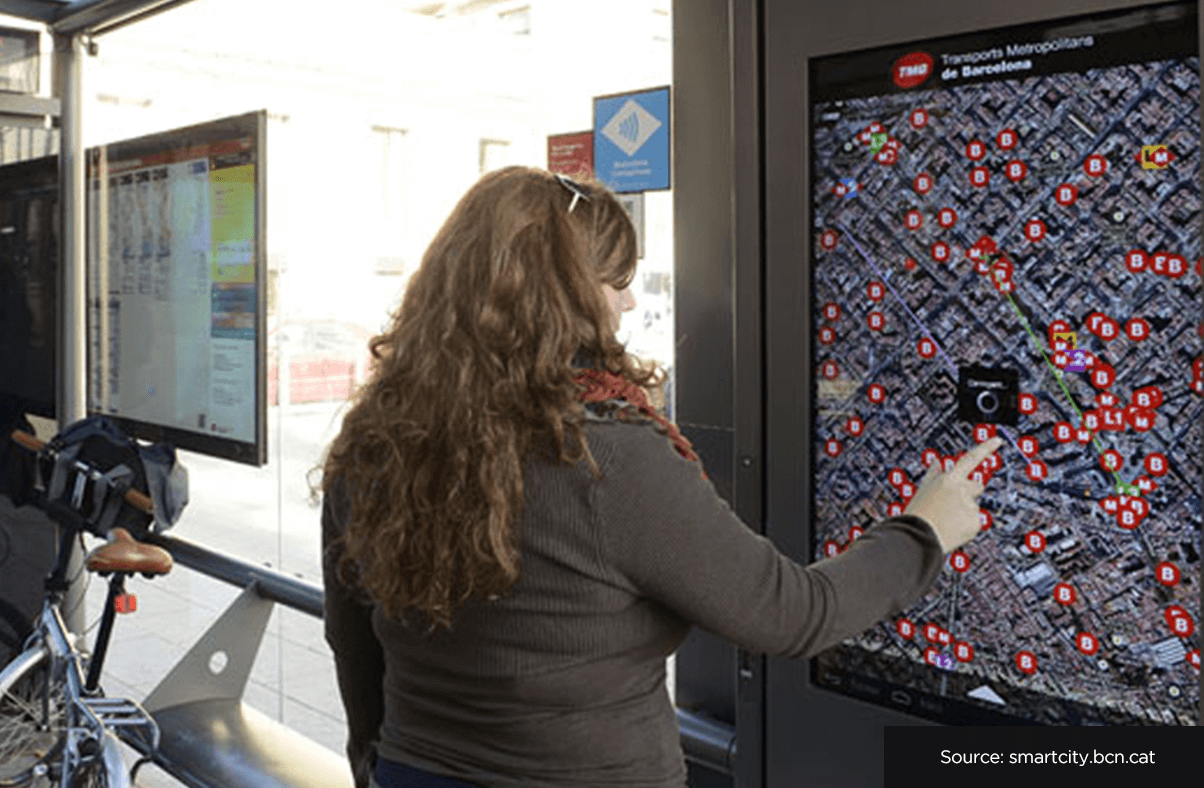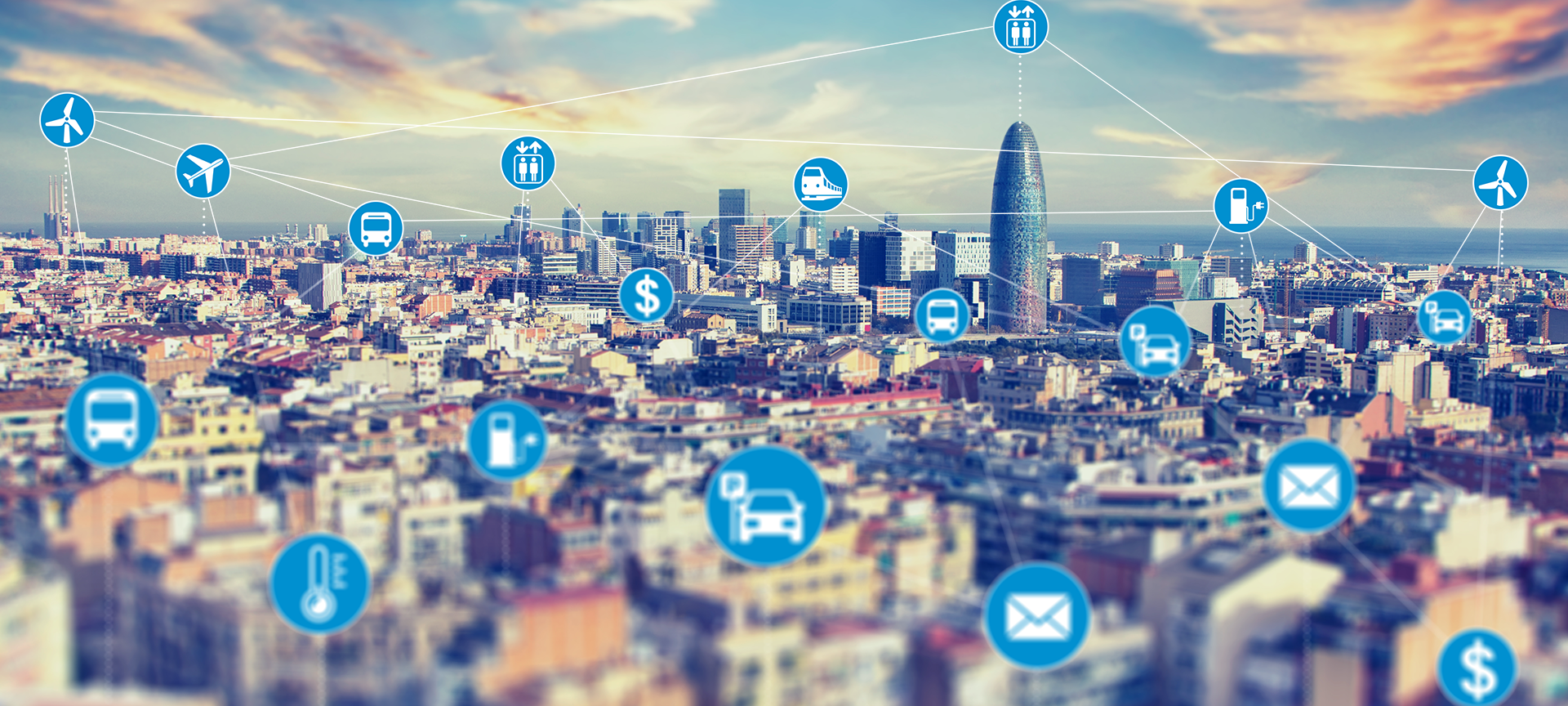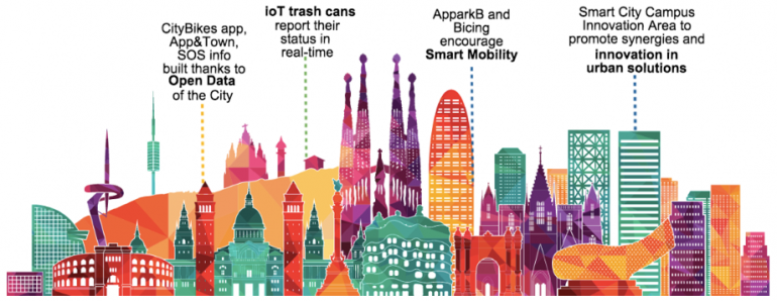The concept of smart city has ceased to be a technological fantasy and has evolved from fancy buzzword to become our hope for a better future. During the month of February we are going to cover in our blog some of the most remarkable examples of smart city implementation.
Singapore, London and Barcelona are three of the ‘smartest’ cities, according to the report Understanding the Challenges and Opportunities of Smart Cities carried out by Philips Lighting and SmartCitesWorld. The report covered 150 variables that have an influence on the urban planning of the cities. Barcelona stands out for creating 47.000 jobs through the implementation of the Internet of Things (IoT) systems, saving 42.5 million euros in water and generating 36.5 million euros in a year thanks to smart car parks.
Rebirth of Barcelona
What makes Barcelona particularly interesting, is how it has reinvented itself over the past 30 years. Following an era of textile manufacturing and commerce, in 1980s the stagnation and unemployment caught up with the city’s industrial dream and its economy was near collapse.
Barcelona’s City Council then decided that the only way to move forward was to transform city’s economy and social profile and promote a new economy based on knowledge industries, modern-city tourism, and quality infrastructure for residents, investors, and visitors alike. As a result, Technology became an essential tool to make Barcelona more inclusive, productive, self-sufficient, innovative, and community-oriented.
In 2010s Barcelona’s strategy and focus to become a smart city started to take shape. City Council started to view the modernization process as a way to reinforce Barcelona’s smart city brand and become a reference for all other cities seeking to redirect their economies.
The Smart City Expo and World Congress, held for the first time in 2011, helped to launch and promote this policy.
Barcelona Smart City Strategy
In 2013, having realized the importance of explicit smart-city strategy, the City Council started to work on one, in order to become
the first truly smart city in Spain. In the process, they also formulated this definition of a smart city:
"a self-sufficient city of productive neighborhoods at human speed, inside a hyper-connected zero emissions metropolitan area". Barcelona aimed at using new technologies and infrastructure to foster economic growth and guarantee a greater quality of life for its citizens.
Several local and regional stakeholders, such as businesses and universities, were involved in the definition and implementation of this strategy. On a reflective note, it can be said that collaboration with other public administrations and public-private partnerships proved highly effective.
In the case of Barcelona’s smart city brand, the Autonomous Government of Catalonia also supported many initiatives when it came to wider projects that included other areas of the region. Cooperation with other cities in Spain, along with European Union support, was also important.

Importance of “enlightened” leaders
Coming back to the report Understanding the Challenges and Opportunities of Smart Cities, visionary leadership was highlighted as one of the success factors for smart city development. The impact of “enlightened” leaders with a long-term vision that commit to the inclusion and collaboration was found very important by the local authorities and professionals from 19 countries that were surveyed.
In Barcelona Smart City its exceptional change in government guidelines was additionally highlighted. We can observe that though other actors participated, the City Council provided explicit direction regarding strategy, programs and projects in the smart-city effort. As a result of this visionary leadership and well-coordinated collaborations, Barcelona is nowadays viewed worldwide as the quintessential smart city.
In March 2014, the European Commission named Barcelona as the European Capital of Innovation, or "iCapital,". The prize is awarded for introducing new technologies that help to stay better connected to citizens. This recognition in turn helped to make Barcelona the “Mobile World Capital” through 2023, that resulted in Barcelona becoming the venue of Mobile World Congress.
 Technologies that Helped to Transform Barcelona
Technologies that Helped to Transform Barcelona
Barcelona, as a smart city, has achieved a wide range of benefits through investment in IoT for urban systems. The high-tech improvements seen throughout Barcelona offer a good example for various other cities looking to improve their technological infrastructure in similar ways. Some of them are listed in continuation:
LED-based lighting system solution has helped Barcelona to become more energy efficient and reduces the heat produced by the old lamps thus leading to cost savings for the city. With the help of the sensors, the system also receives information regarding the pollution, humidity, temperature, the presence of people, and noise.
The use of smart bins that use a vacuum and suck the waste into underground storage helps to reduce the smell of trash waiting to be fetched and the noise pollution from collection vehicles.
It also enables the city to detect the level of waste that comes from different places and optimize the collection of waste, which decreases both the resources and time needed for this service. Meanwhile, the incineration of waste is used afterwards to produce energy for heating systems.
After many years of public bicycle sharing it might seem just another service, but back in the day Barcelona was one of the first and largest cities to implement the system. This initiative is aimed at reducing the number of cars circulating in the city. Despite occasional controversies, Bicing can still be considered a success with its over 120,000 users.
The bus transit system stands out for sustainable mobility and decreasing emissions with the help of hybrid buses. This system also has smart bus shelters utilizing solar panels to provide energy for the screens that show waiting times.
The residents of Barcelona’s Plaza de Sol, who had complained about the nighttime noise for decades, used low-cost and easy-to-use sensors that can detect air pollution, noise levels, humidity and temperature to detect and prove that the noise levels were almost 100 decibels which were beyond the recommendations of the WHO. Armed with this information, the residents went to the city council, pressing them to rethink the use of the plaza.
Various sensors in the ground offer live data on humidity, temperature, wind velocity, sunlight, and atmospheric pressure. That means, for example, that gardeners can decide what the plants need based on that data and adapt their schedule to avoid overwatering. It was estimated that the city will earn back its initial investment in building the first phase of the system in one year when they cut water usage by about one quarter.
Barcelona was the first city in the world to have a public network of fab labs, small-scale workshop offering (personal) digital fabrication. The premise of this enterprise was simple: “no smart city without smart citizens”. Citizens play a key role in the development of smart cities, therefore it is important that they can participate in the changes at grassroots level.



 Technologies that Helped to Transform Barcelona
Technologies that Helped to Transform Barcelona